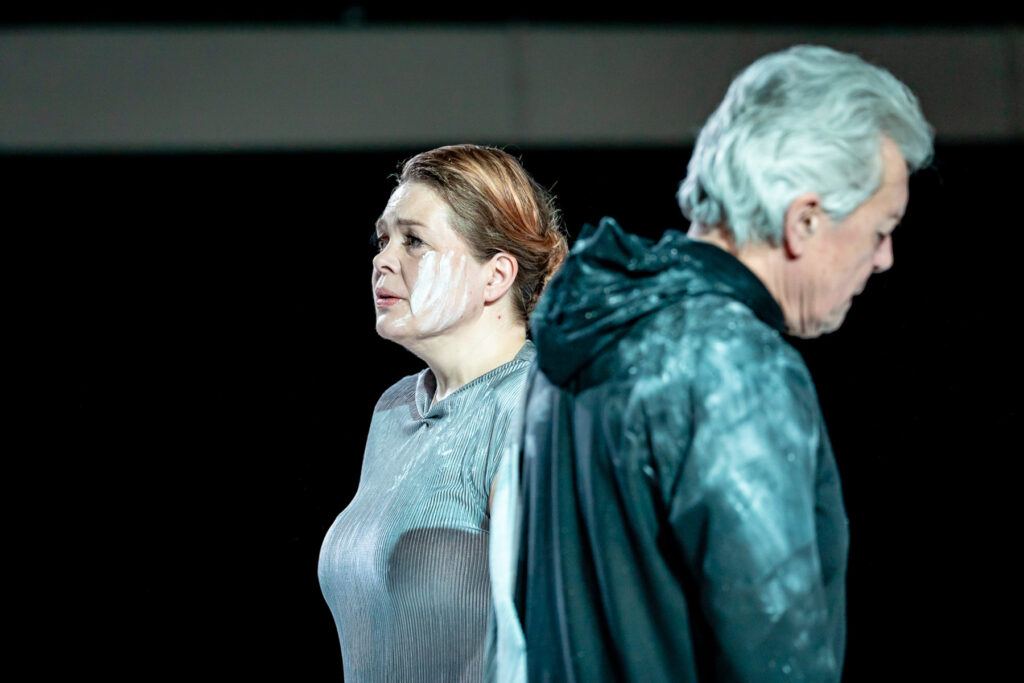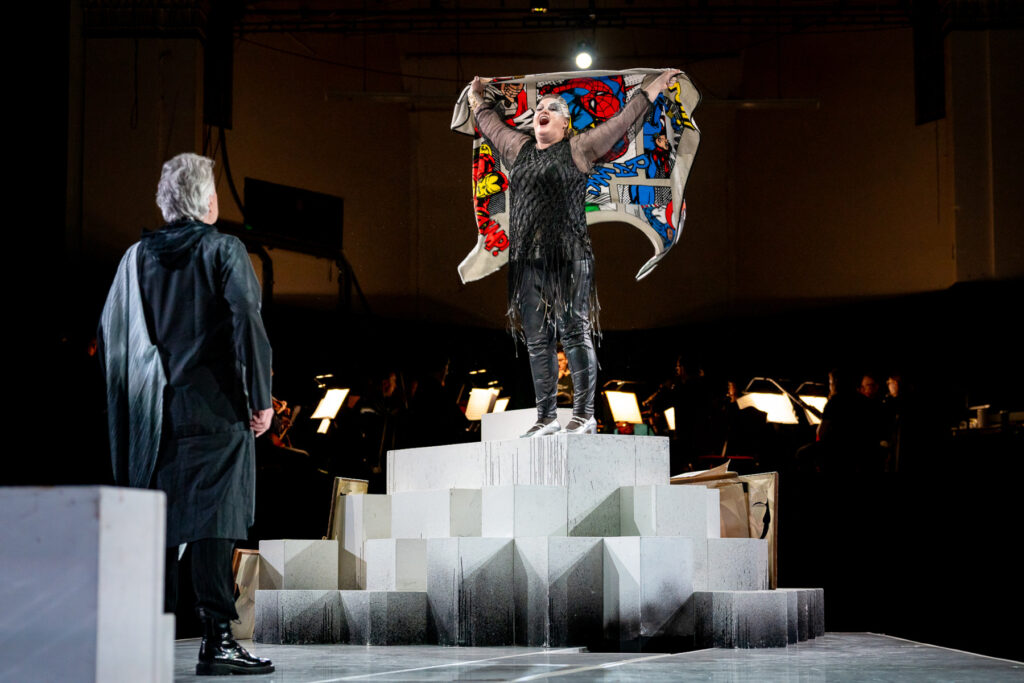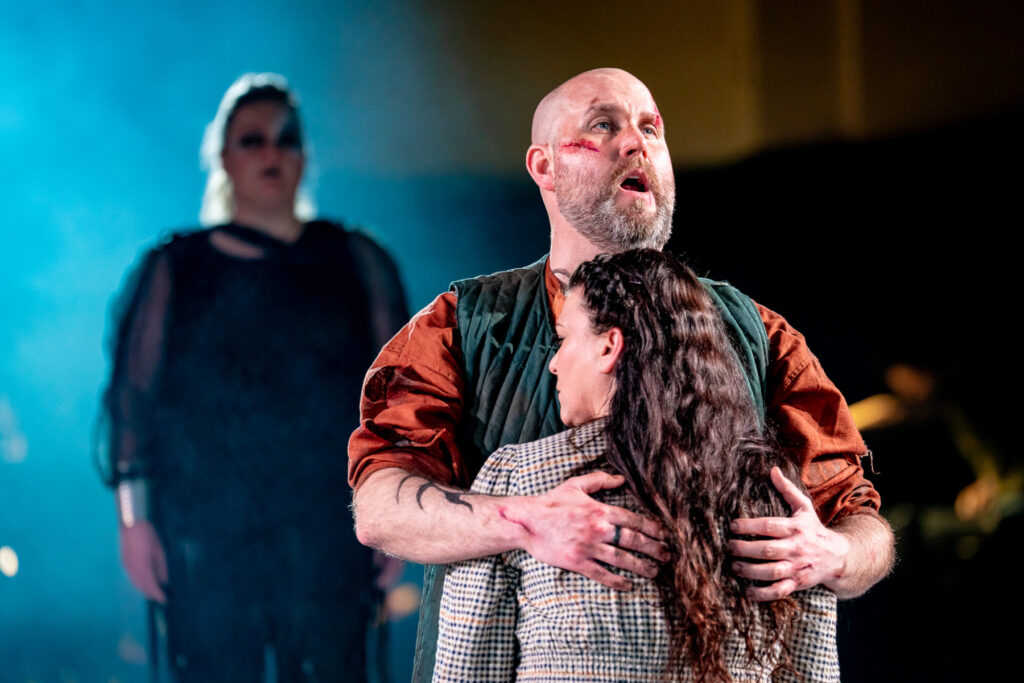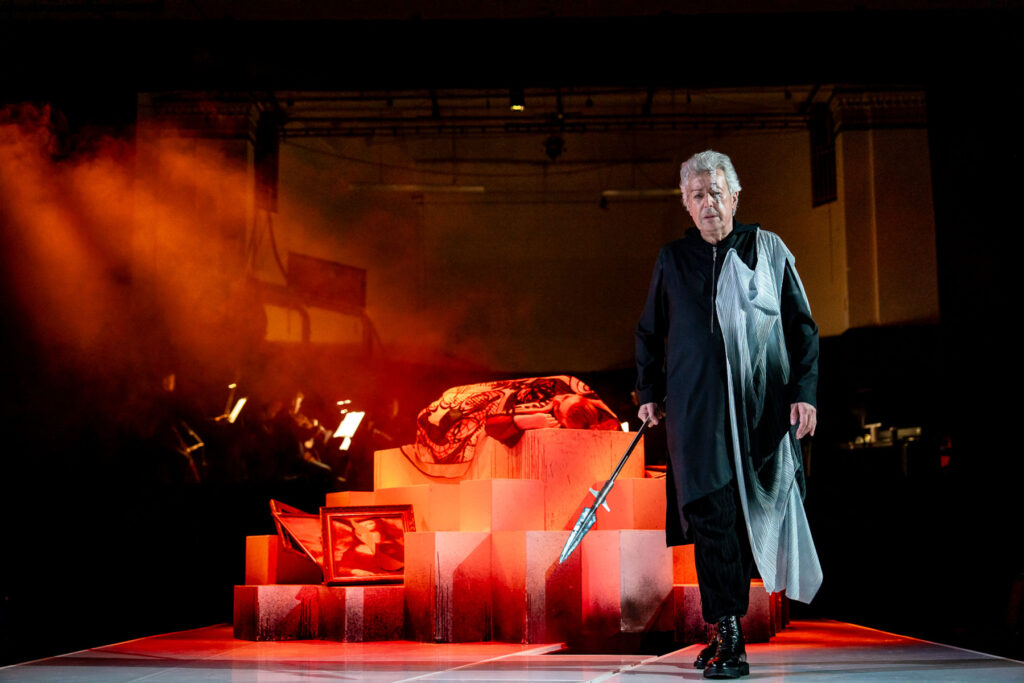A kitchen sink drama really is nothing new. It’s been around for as long as human beings have been inhabiting a shared domestic space. The first act of Wagner’s Die Walküre sees temper tantrums in the home of Hunding and the following act has similar strife in the mother-and-father of all verbal battles between Wotan and his wife Fricka. Though there is plenty of interiority elsewhere, such moments of dramatic intensity give this opera a cutting edge. It is an example of how Regents Opera’s Ring cycle is warming up nicely that the protagonists seize such opportunities with alacrity. Even though not everything is coherent and consistent in this production, the ripples of flowing energy together with the full commitment of singers and players are palpable throughout.

Hunding’s hut for Act 1 is simple and spartan: two moulded bucket chairs, a centrally placed plinth with space for an electric toaster (supplying Hunding’s sustenance) and drinking vessels, together with a modern fire extinguisher. During the initial storm sequence Sieglinde busies herself with a tailor’s dummy whose symbolic significance is later revealed. Why, however, does she wear high-heeled boots in her own home? When Siegmund enters, he looks as though he’s been in the wars. Brian Smith Walters is more of a baritonal tenor than a proper Heldentenor, so the heroic force in his voice comes across strongly in lines such as “Wälse! Wälse! Wo ist dein Schwert” just before he pulls the hilt of his sword from inside the central plinth. Yet there are also many moments of lyrical tenderness in his exchanges with Sieglinde; my only quibble here is that I wanted the electric charges between the two twins to be more pronounced. It’s there in the music, after all.

Justine Viani sings a very credible Sieglinde, impassioned when she relates her back story, with a gleaming brilliance in her upper register and a welcome richness in her chest tones. She is suitably on edge whenever Hunding is on the scene, and both she and Siegmund, rather like professional dancers negotiating the entire space in a ballroom, move around the central stage area very intelligently. The tailor’s dummy, which I take to represent her own maternal longings, is later embraced by both twins as a symbol of their incestuous union and the child that Sieglinde will eventually bear. I was also glad to see more use being made of the horizontal; previously in Das Rheingold there had been an over-emphasis on the vertical. You can immediately sense the spiv in Gerrit Paul Groen’s Hunding, kitted out in a checked grey-and-white three-piece suit. His inky-black bass always has more than a touch of menace, his cruelty frequently on display in his treatment of both Sieglinde and Siegmund.

Much of the second act revolves around the confrontation between Fricka and Wotan. Their union is neatly reflected in their colour-matched attire: sea-green and black. Earlier, in Das Rheingold, Ingeborg Novrup Børch had been quite restrained, but here she unleashes the deep well-springs of resentment and fury she feels, not only because of Wotan’s own adultery and treatment of her as little more than an appendage, but also because of the protection he intends to afford Siegmund. Relishing all the power in her deep mezzo, her tirade against Wotan (“So führ es denn aus! Fülle das Mass! Die Betrogene lass auch zertreten!”) reaches its apogee as she collapses on the floor, beating her fists furiously.
Act 2 also sees the first appearance of Brünnhilde, dressed together with all her other sisters like a Goth, her long, brightly-coloured shawl giving her the look of a comic-strip character. Catharine Woodward does the insolent teenager very nicely, standing up to her father in repeated rebelliousness, but what equally impressed me were the moments of filial love shown towards Wotan, covering him sympathetically at one point with her shawl, as well as her evident concern for Sieglinde’s welfare. She sings her role most impressively: her steel-edged dramatic soprano soars effortlessly, pitch-secure in all her registers, and with a coruscating brilliance in her top line. Like all the other protagonists, she moves across the performing space with purpose, let down only very occasionally by a fussiness in the stage direction. During the course of the fray with her father, she is required to remove a succession of pewter-like figurines from her black-cloth satchel, mounting them on five successive plinths, only to retrieve them all again after Wotan has smashed one of them in rage. Ralf Lukas as Wotan is in much better voice than for Das Rheingold, the steadiness and warmth in his baritonal depths giving his character both authority and humanity. At the end of this act, Siegmund and Hunding return to battle it out: uniquely, in my experience, Siegmund is killed by a fire-extinguisher, and Hunding the culprit is himself despatched without weaponry by the ruler of the gods.

Act 3 opens with one of the most famous Wagnerian set-pieces, the Ride of the Valkyries. What a glorious vocal octet we had here, lusty and defiant in manner, each holding up a different picture (Munch’s Primeval Cry, Caspar David Friedrich and Frida Kahlo among them), their strong and splendiferous voices echoing majestically all round York Hall. A more imposing demonstration of collective female vocal power is difficult to imagine. The Valkyries then retreat to a white geometric construction streaked with grime which later serves as the mountain summit where Brünnhilde is encircled with protective fire. On her arrival, Sieglinde receives the pieces of broken sword from Brünnhilde and Viani then responds (“O hehrstes Wunder! Herrlichste Maid!”) in tender gratitude before the next dramatic thunderclap. This is the confrontation between Wotan and his eight daughters: their defence, rather like cloves of garlic held up to ward off evil, is to thrust their pictures in his face. He in turn smashes all of them. A final sally from Wotan comes when he takes a coil of white duct tape and wraps it around Brünnhilde’s chest, penning the word “Entartet” on her back. Sadly, this makes no sense. The Valkyries’s pictures do not fall neatly into the Nazi categorisation of degenerate art, and in any case this kind of comment from a father to his daughter negates the earlier evidence of Wotan’s own humanity.
Holding everything together with an assured musical hand was the conductor Ben Woodward. We had all the notes that Wagner wrote, and all in the right order. Even with fewer than two dozen players there was no loss of dramatic impact. Many instrumental details delighted the ear during the course of the evening, Woodward drawing soft lyrical suppleness from his ensemble for the exchanges between Sieglinde and Siegmund, and highlighting the powerful bass trombone as the Magic Fire Music drew to its close. It is one thing to sing these challenging roles well, with the vocal stamina required; it is something else to bring each character convincingly to life. Regents Opera does Wagner proud. Less is indeed more in this setting, and with this crew; the quality of the overall performance is not once in doubt. It beggars belief that three requests for funding submitted by Regents Opera were imperiously rebuffed by the Arts Council of England. Those whom the gods wish to destroy they first make mad.
Alexander Hall
Die Walküre
The first opera in the Ring cycle
Libretto and music by Richard Wagner
Sung in German and with English surtitles
Arranged for Regents Opera by Ben Woodward with sections of Act 3 arranged by Jonathan Finney
Cast and production staff:
Siegmund – Brian Smith Walters; Sieglinde Justine Viani; Hunding – Gerrit Paul Groen; Wotan – Ralf Lukas; Brünnhilde – Catharine Woodward; Fricka – Ingeborg Novrup Børch; Gerhilde – Charlotte Richardson; Helmwige – Shannon Roberts; Waltraute – Catherine Backhouse; Schwertleite – Gráinne Gillis; Ortlinde – Ella de Jongh; Siegrune – Magdalen Ashman; Grimgerde – Grace Maria Wain; Rossweisse – Caroline Carragher
Director – Caroline Staunton; Set Designer – Isabella van Braeckel, Lighting Designer – Patrick Malmström; Regents Opera Orchestra – conductor, Ben Woodward
York Hall, London, 11 February 2025
Top image: The eight Valkyries
All photos © Steve Gregson
The second of two cycles begins on 23 February